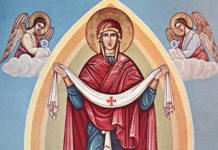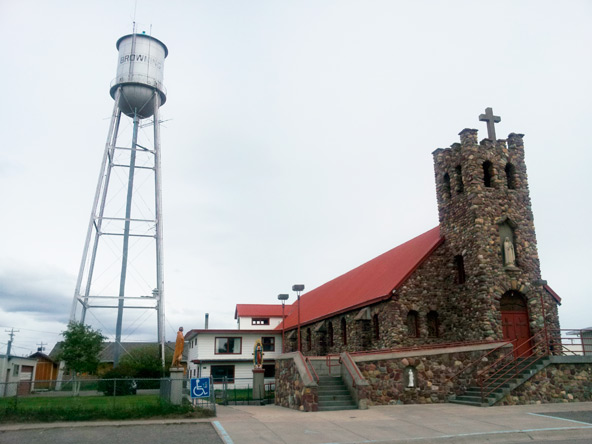
When the White man came to North America
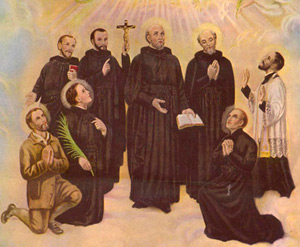

Jesuit Father Jean de Brebeuf, in France for his final vows in 1633, returned to his difficult missionary life in Quebec. When someone would comment on the many hardships he endured living among the Huron Indians, he would respond, “Compared to the end, this is roses.”
Captured from the Hurons by Mohawks who were allied with the Iroquois, he was tortured to death on March 16, 1649. A torture game was played with Indian captives. If they broke, they lost. By showing weakness, their oppressors enjoyed their agony — the weakness of their enemy — all the more. But if they could antagonize their captors sufficiently with taunts and insults, while showing no sign of pain, they won. And there was always the possibility they might infuriate them sufficiently to be quickly dispatched just to shut them up. Fr. de Brebeuf merely bore his awful suffering in heroic silence. His tortures were so horrific that the Indians, wishing to become like him, drank his blood and ate his flesh and heart. Tortured with him was fellow Jesuit Gabriel Lalemont, who died the following morning.
They and four other Jesuits and two laymen were martyred between 1642 and 1649. One by a Huron apostate, the rest by Mohawks. Christianity got off to a slow start among these Natives, but eventually the faith began to grow under the influence of the “blackrobes” and as a result of their martyrdoms. There were parallels between some elements of Native and Christian belief, yet conversions were complicated by many factors including the British, French and Indian politics, superstitions, and misunderstandings.
Kateri
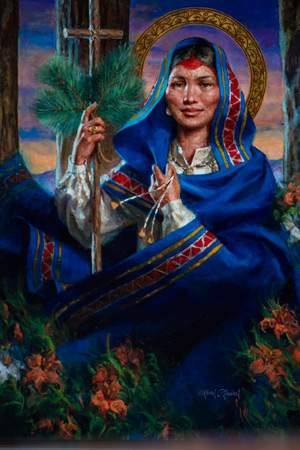

Kateri Tekakwitha, was born in 1656 to a Mohawk father, who may have been a participant in the martyrdoms. Her mother was an Algonquin Catholic. Living a Catholic life of intense holiness and mortification, she wanted to start an Indian order of Sisters, but her spiritual director advised against it. She died at age 24, a holy virgin laywoman, vowed to celibacy.
Fast forward 330 years to the Catholic Medical Association Meeting in Seattle, 2010. My wife and I walked with our lunch plates to sit at a table with a lady sitting alone. She introduced herself as Mary DesRosier. Over lunch, she told us she was an M.D. family practitioner, and a member of the Blackfeet Indian tribe, working on the Reservation where she had grown up, in Browning, Montana.
Since I had spent the previous 12 years working for the Indian Health Service in Phoenix, we had a number of things in common. She mentioned the strong faith life on her reservation, and I told of the difficulties in development of the faith in Arizona tribes I had encountered. “Well,” she offered, “I have a willing group of my tribe who will go anywhere and assist other Native Americans in a Cursillo.”
“Even to Arizona?” I asked.
“Sure, anywhere,” she responded.
How did Catholicism get so well established among the Blackfeet tribe?
Jesuit Father Tom Connolly is a good friend of Dr. DesRosier and her family. Sometime after our meeting, she sent me an excerpt from his book, “Visions of Chiefs and the Iroquois Connection: The Northwest Tribes and the Catholic Way”:
“Visions came in the late 1700s to Chief Shining Shirt of the Pend d’Oreilles in Mission Valley, Montana, and to Chief Circling Raven of the Coeur d’Alenes in Idaho that one day men would come in black robes and teach new truths about religion that would be important for the people. Some years later Catholic Iroquois spread throughout the west working as canoemen for the Hudson’s Bay Company. They too spoke of a new religion and of men in black robes who carried a crucifix and said a great prayer. These early traditions had a dramatic meeting in Montana’s Bitterroot Valley south of Missoula in 1820. A band of Catholic Mohawk Iroquois . . . migrated west under the leadership of Ignace LaMousse and finally settled among the Salish Flatheads in their Bitterroot Valley. Ignace taught the sign of the cross and the Catholic prayers to the Flatheads, baptized their children, and marked their graves with a cross. He urged the need for Blackrobes who could say the great prayer among them.
“In 1831 a delegation of Flatheads and allied Nez Perce journeyed some 1600 miles to St. Louis to seek Blackrobes for their people. Their deaths coupled with unavailability of Catholic priests who could relocate west prevented the acquisition of Blackrobes. In 1835 and again in 1837, Ignace LaMousse traveled to St. Louis to petition for Blackrobes. However, a Sioux attack on the South Platte River resulted in the deaths of LaMousse and his party.
An 1839 delegation, however, encountered Fr. Peter De Smet, S.J. in Council Bluffs, Iowa and convinced him to come to the Flatheads. Upon arriving in the west in 1840, De Smet was so impressed with the eagerness of the Flatheads, their background in Christianity, and their high standard of morals that he returned shortly to St. Louis to obtain other priests and financial support for the founding of Catholic missions in the Rocky Mountain west.
The Catholic Iroquois had done their missionary work well. When De Smet returned in 1841, he found many of the western tribes eager to have their own missions and to gain the material and spiritual benefits of the Blackrobes’ religion. In rapid succession De Smet and his fellow missionaries founded large mission establishments — “mother missions” — among the Flatheads in 1841, the Coeur d’Alenes in 1842, the Kalispels in 1844, and the Colvilles in 1845.
In later years permanent mission churches and schools were also developed with other tribes of the Jesuit Rocky Mountain Missions: the Blackfeet in 1862, Spokanes in 1866, Yakimas Assiniboines in 1885, the Crows and the Okanogans in 1887. This was the legacy of Kateri Tekakwitha passed on through her people to
the Iroquois canoemen who brought it west–where it found eager hearts prepared by the ancient visions of Shining Shirt and Circling Raven.
— Excerpted and edited from “Visions of Chiefs and the Iroquois Connection: The Northwest Tribes and the Catholic Way,” by Fr. Thomas E. Connolly, S.J. (Pastor, Sacred Heart Mission, DeSmet, ID)
Thus were the Blackfeet and surrounding tribes brought to the faith through the great evangelistic efforts of the Mohawks, and the spiritual descendants of the North American Jesuit martyrs. The Blackfeet were actually assigned to the Methodists by the Federal Government in the late 1800’s, but the Methodist minister relinquished his post to a nearby Jesuit missionary and today the majority of the tribe is Catholic.
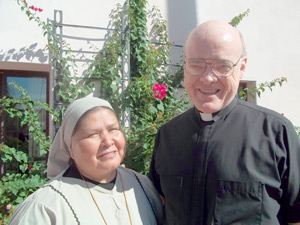

It’s funny how things come together. I usually see Fr. Matthias Crehan, OFM once a week or so at the Phoenix Hayden VA Hospital for Mass. So I was talking to him about the Indian Cursillo, Dr. DesRosier, and Sr. Clissene Lewis, whom I had read about in Our Sunday Visitor.
Turns out, Fr. Crehan, who has worked with Arizona Indians many years, knew Sr. Clissene well. He also knew that Cursillo had figured prominently in discernment of her religious vocation, which included forming her own religious institute. Now, more than three centuries after Kateri Tekakwitha, perhaps another Native American woman would be able to bring both of their dreams to fruition, of an Indian religious community of women.
Things begin to move
Last July, I visited Dr. DesRosier again, this time in Browning, and met her family and some others in the community. Planning for an Indian Cursillo in Arizona was apparently moving ahead quickly — Bishop Thomas J. Olmsted was in Browning a week later, talking to a very surprised and puzzled Fr. Ed Kohler, pastor of Little Flower Catholic Church.
Through email, Dr. DesRosier wrote Sr. Clissine that “…the Cursillo movement hit the Blackfeet Reservation in the late 1970’s. It took the reservation by storm and set the people on fire for Jesus and has completely changed the face of the reservation in those 30+ years.”
She noted they had developed some other programs based on Cursillo, including “Search” for high school students and “Pilgrimage” for people recovering from addictions. Besides that, she told Sister there were teams of men and women from Browning, going to reservations all over the northwest to assist in Cursillos. She invited Sr. Clissene to participate in their Cursillo program. Thus sister was in Browning in June for the women’s Cursillo.


It’s hard to imagine Dr. DesRosier more excited about the faith than she is on any day of the week. But if so, it must have reached that point when she was able to go to Rome with other Indians from all over America last October for the canonization of St. Kateri Tekakwitha.
There was Native American Archbishop Charles Chaput celebrating Mass, with Indian dancers, singers, and drummers participating in St. Kateri’s elevation to sainthood. The following day, serving as a lector for the first time in her life, was Dr. DesRosier, reading the epistle in Rome at St. Mary of the Angels of the Martyrs Basilica. There were 750 Native Americans in front of her, and the relics of the saint at her feet.
Cursillo in Browning
I arrived in Great Falls, Montana 5-ish the day before the Cursillo began. The rain had stopped and I was soon picked up by Dr. DesRosier and daughters Emma and Rebecca, with a new grandson she was babysitting. Did some shopping, running around, then off to Browning, as I got the history of Indians who had lived for thousands of years in this area, living off buffalo and what they gathered. They had once worshipped a single creator God, assisted by spirits who were possibly analogous to angels. They awaited a holy person who would someday come to them from the east.
The sun figured prominently in their worship, but only as a sign of God. Their beliefs and some of their ceremonies could very easily expand onto Catholic theology, including themes of sacrifice and redemption. Conversion of these people really sounds more like a fulfillment or completion of what was already solidly in place. In the Cursillo, Fr. Kohler would emphasize that the Blackfeet religion was a true religion that set the stage for, and easily transitioned into mature Christianity. Yet a barrier that had to be overcome was the reluctance to make peace with traditional enemies. And with the changes due to advancing European immigration and civilization, there was great suffering and hardships yet to be endured. Even today, prejudice and injustice persist.
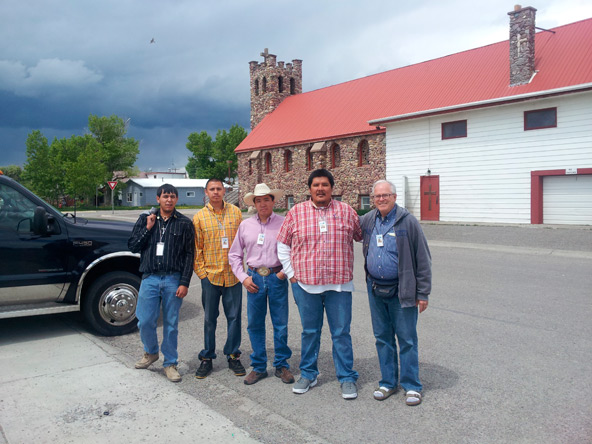

Catholic community with problems
Browning is a reservation town. It is a very tough place in which to grow up or live. I would guess everyone knows someone who has died violently. Drugs and alcohol are rampant. Terrific fights and beatings are commonplace. Murders happen. Speeding and other risk taking (I heard mentioned 120 mph — perhaps on a popular, curvy drag racing road up by Glacier National Park, with many sheer drop offs) is fairly commonplace adolescent entertainment. I sat next to a guy with a mild mental disability who got that way after someone drove a car over his head trying to kill him. I heard talk about pimping for girl friends and beating them up. Unemployment is 70 percent. Too many spend what they have at their casino, making social problems worse. About the only good news is that pregnancies don’t seem to end in abortion very much, children even if illegitimate seem valued.
Yet there is a fabric store I visited, with an entire shelf devoted to cloth with religious themes, including about five bolts with various representations of Our Lady of Guadalupe. And people in general, in spite of their ways, seem to know the Lord — mostly as Catholics — and know where to head when things really get tough.
Little Flower Catholic Church in Browning was made of cabbage-sized native stone, in 1931. A statue of St. Therese of Lisieux stands high over the entrance. To the left are statues of Our Lady of Guadalupe and St. Kateri Tekakwitha. Behind the altar is a beautiful façade of rough sawn wood, intricately arranged in radiating geometrical patterns. A life-size bronze crucifix behind the altar is unusual, with Jesus facing upwards to God, interceding for us. It was done by local artist, Gordon Monroe.
Across from the church is the Catholic school with grades 4-8. There are about 70 students. The faculty includes two — soon to be three — Christian Brothers.
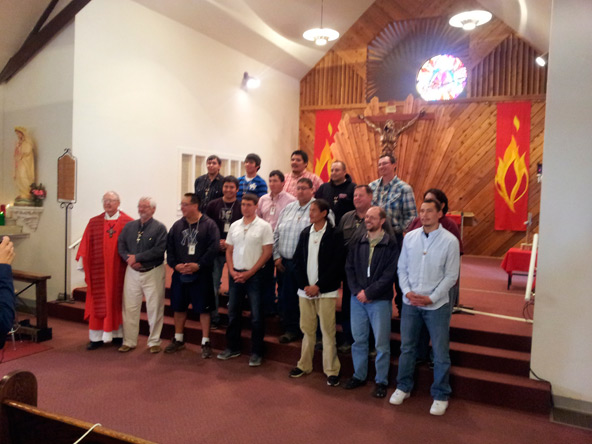

Deacon Ron Running Crane was the Rector of this Cursillo. Father of five sons and 32 grandchildren, he is retired from the Tribal Police Department. He speaks the Blackfeet language, which he says is understood by brown (grizzly) bears. He tells about an occasion where he came upon a grizzly sow with two cubs – normally a very dangerous situation – people are still mauled and killed by these bears in and around the national park. He merely talked to her calmly, reasonably, in Blackfeet, and told her that she needed to go away from that area because otherwise men would come and shoot her babies. He relates that she regarded him a few moments, then turned around, watching him a little longer, and with her cubs, slowly ambled away.
Thoughts of Mount Claret
The Cursillo I attended at Mt. Claret in Phoenix last year was quite sophisticated. Most of the talks could have been used as homilies. If the talk was on “Piety” that was what was talked about. We were given a single sheet with the words to “De Colores” and that is what we sang, again and again.
In Browning, the Cursillo was in the Catholic school building, and we slept in the gym. A talk on “Piety” could be on whatever the speaker had in mind and chances were good that he would leave everyone knowing no more about piety than when they first walked in. At any given time there was always at least one musician playing a guitar, but there could be as many as six, with more guitars, a walking bass, and violin. We were given a booklet painstakingly created by volunteers, which had over 60 songs, and we sang at every possible opportunity. I don’t think anyone understood “De Colores”, but it didn’t lessen their enthusiasm for singing it, right along with “Do Lord”, “Father Abraham”, “This Little Light of Mine”, “How Great Thou Art”, and “What a Friend We Have In Jesus”.
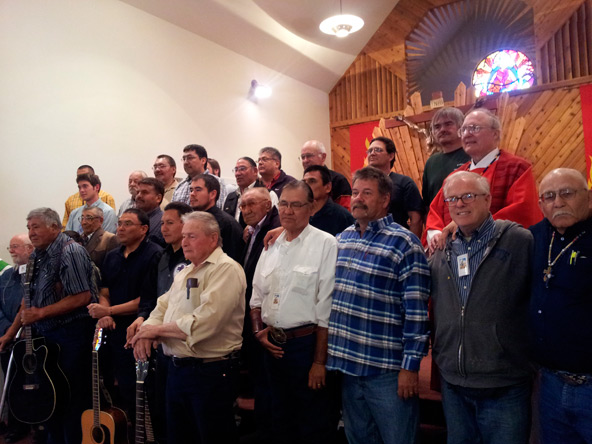

The University of Hard Knocks
The education of all the Cursillo leaders was at the school of hard knocks. All had a history of a difficult life, which had in most cases been eased by a Cursillo which had set them on the right path. Here was the real power and spirituality of what went on this weekend. Because these humble, poorly educated, elders spoke to the younger participants in a language they understood. “You young guys have nothing on us,” one said. “I once had a $2300 a week cocaine habit, I did other drugs, and you name it. We’ve been through it all. You can talk to us. And we need you to join us.” And the young candidates, many recovering from addictions and enmeshed in other problems listened carefully. The elegant sophistication of Mt. Claret would have likely been lost entirely on most of them.
Father Kohler drew them in too. Ordained in 1982, his first assignment was Browning, and other than a 5 year interlude in Guatemala, his whole life has been there, living as a missionary. What intellectual content may have been lacking in the conferences was more than compensated by Father’s perfectly understandable, well constructed homilies. There were many expressions of love and reverence for him.
In the midst of activities on Friday, Father Vitus from Nigeria dropped by with his friend, Zachary on their way to the Park. Would Father like to give us a talk? Yes, he would be happy to, and we had the bonus of another wonderful homily, about the need to rescue our wives and children from the evil that surrounds us, as David and his men once did from the Amalekites in I Samuel 30. Afterward, his friend Zachary told us how he had been a Satanist, and how he had seen the Eucharist disrespected. It was commented that remarkably, Satanists do not doubt the real presence as do many who call themselves Catholics.
Friday night Father Ed heard confessions, and everyone received Communion at Mass the next day. At the conclusion, when everyone shared, most if not all stood up and expressed appreciation and that they intended to change their lives.
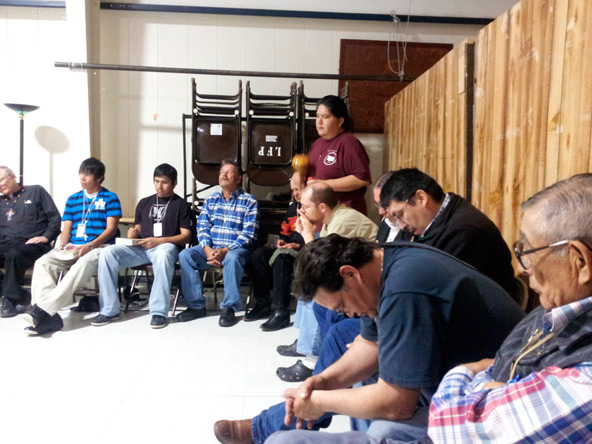

From Phoenix with love


Representing the Diocese of Phoenix were Deacons Jim Trant and Ronald Poulin. At the conclusion, James Sundust, who accompanied the Phoenix deacons, talked about his Maricopa and Pima tribal culture, and sang a song of enthusiasm about new beginnings. He sang in his Native language, with a special rattle. His gift of song and the appreciation he received was thoroughly convincing of the power of Native American people to mold the Cursillo experience to fit their cultural needs.
Perhaps the most heartwarming experience was the email from the Cursillistas in Phoenix, with their well wishes and list of thousands upon thousands of Rosaries, Chaplets, Masses, and other prayers for our Cursillo. I think everyone was touched by this outpouring.
For my part, I love that they called me “Brother,” and anxiously look forward to what I hope will be many of them coming in the Fall, to help with the first Native American Cursillo in the Diocese of Phoenix.




